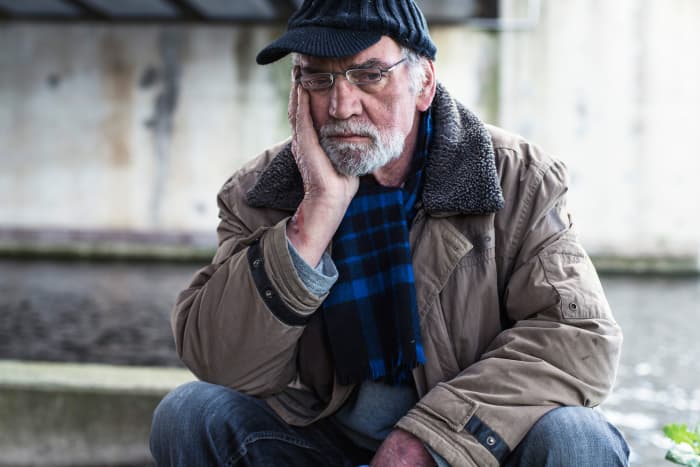People aged 65 and older are the fastest-growing group of people who are homeless and their ranks will peak by 2030.
This daunting forecast comes amid escalating rents nationally, stubborn inflation and a potential recession that compounds woes for baby boomers who have minimal savings for retirement. It also comes as traditional workplace pensions are increasingly rare and workers must rely on the savings they have accumulated through their working lives. About 27% of people who are 59 or older have no retirement savings, according to a survey from Credit Karma.
According to a 2019 study by University of Pennsylvania and others that analyzed the populations of homeless shelters in New York City, Los Angeles and Boston that predicted by 2030, the number of people 65 and older who are unhoused will nearly triple compared with 2017.
University of Pennsylvania professor Dennis Culhane says this significant growth, especially in those 65 and over, will continue nationwide through 2030.
Read: How real Americans are living the ‘Nomadland’ life
“Beyond 2030 the numbers should wane, as the second half of the baby boomers reaches their life expectancy. How far it will wane will depend on whether the forces underlying homelessness get worse or not. But all other factors equal, the generation behind them is substantially smaller and that should be reflected in reduced elderly homelessness,” said Culhane, the Dana and Andrew Stone Professor of Social Policy at the University of Pennsylvania.
There’s not an exact figure on the number of unhoused older adults in the U.S. because of the way the government currently tracks information for all adults ages 25 and older; it doesn’t break down adults into subcategories.
In 2022, the Department of Housing and Urban Development (HUD) said about 582,000 Americans experienced homelessness, an increase of about 2,000 people from 2020. That represents about 18 unhoused people per 10,000 people in the U.S.
The problem is even worse for minorities. The homelessness figures jump to 52 per 10,000 for Blacks, 45 for Native Americans and 109 for Pacific islanders, according to the 2022 State of Homelessness report by the National Alliance to End Homelessness.
Patti Prunhuber, director of housing advocacy at Justice in Aging, a legal advocacy group focused on senior poverty, pointed to escalating rents, depleted savings, loss of a spouse or partner, or an unexpected medical costs, or a loss of a job because of injury as factors contributing to older homelessness.
According to new research from the New School, between 2013 and 2020, the share of low-income older households who had to pay rent exceeding 30% of their income increased from 18.2% to 23.7%.
“It takes just one crisis to push someone who is rent-burdened onto the streets,” Prunhuber said.
Many of the older homeless adults are newly unhoused. Margot Kushel, the director of the University of California San Francisco Center for Vulnerable Populations, said nearly half of single adults 50 and over experiencing homelessness had never been unhoused before age 50.
“First being homeless after 50 looks very different than lifelong homelessness. It’s hard in your 50s and 60s getting back into the workforce anyway, but add in that these are low-wage, physically demanding jobs often that these people had and they can’t physically do them anymore,” Kushel said.
Kushel said that those who are first homeless after 50 tend to stay unhoused and they tend to die faster than those who have experienced homelessness throughout their lives.
“The gap between what people make and what they need is insurmountable. Add in racism and poverty making people age prematurely. This is what happens when you don’t give people pensions and when service jobs pay so little. It’s really a catastrophe,” Kushel said.
Meanwhile, living on the street is hard for anyone, but especially older adults who may suffer from a lack of medication, access to bathrooms, suffer from attacks and violence and may lack necessary help with activities of daily living such as dressing, feeding themselves and bathing, Prunhuber said.
“Many older adults who are experiencing homelessness have an acceleration of geriatric conditions. They age much more quickly and have exacerbated health conditions. Their chronological age may be 55 or 60, but they have the health of a person 15 or 20 years older,” Prunhuber said. “Their health degrades so quickly when living on the street.”
Homeless seniors often use costly acute healthcare services and die prematurely. A Journal of the American Medical Association study found that unhoused people over 50 years died at a rate 3.5 times greater than their housed counterparts.
Addressing homelessness among older adults will require increasing the supply of affordable housing, targeted prevention efforts, and expanding permanent supportive housing, adapted to older adult needs, Prunhuber said.
Still, getting enough affordable housing built and available takes time. And even then, getting rehoused after being on the street is challenging, Prunhuber said.
According to the National Low Income Housing Coalition, there are only 36 affordable and available rental homes for every 100 extremely low-income renter households nationally.
“Affordable housing is great and needed, but we also need deeply affordable housing. A lot of affordable housing is still out of reach for people who may be living on less than $1,000 a month,” Kushel said.
The focus needs to be on preventive measures, Prunhuber said.
“Increasing the supply of affordable housing is important, but we can’t build our way out of this problem. We need to focus on preventing older adult homelessness,” Prunhuber said.” Prunhuber said.
The homelessness service groups are maxed out in their ability to help and those homeless after 50 may not have the substance use or mental health problems of other adults who may get services faster because of their other issues, Kushel said.
“These are our older neighbors and caregivers and preschool teachers and landscapers who have exhausted their ability to work and they are at risk. It’s important we not distance ourselves from the people who contributed to and built our communities and now they need help to stay in that community,” Prunhuber said. “We’re all aging.”







